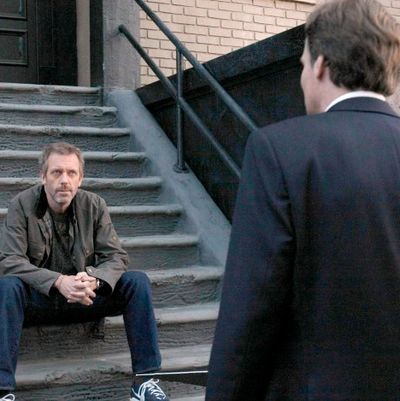
When House debuted in 2004, America was in the throes of its antihero revolution. Those were the days of Tony Soprano and Vic Mackey, of Jack Bauer and Al Swearengen, of Rescue Me and Huff. Today’s TV overflows with bad guys, too — oh boy, does it — but Gregory House doesn’t fit with Dexter, or Don Draper, or Walter White, because we’ve seen all those characters change. And for better, though often for worse, House himself hasn’t changed a bit. He’s stuck to his mantra that everybody lies, and his emotional fortress remains intact. Tonight’s series finale, the show’s 176th episode, finds its central character just as he ever was: sad, scraggly, sharp, verbally abusive, and mostly alone. Who is it that always says people don’t change? Oh right. House.
At the outset, House was a dazzling reminder that procedural was not synonymous with terrible, that the TV ecosystem could still support a new and inventive hospital drama, and that David E. Kelley and Aaron Sorkin weren’t the only people who could write intense, meaningful male friendships. The relationship between House and his best friend and frequent punching bag Wilson remained the show’s strongest feature, which has made Wilson’s torturous battle with cancer this season all the more demoralizing. There’s a line between enlightened cynicism and the misery-entropy the show has been listing toward more and more each season. As the show wore on, its dramatic flare dimmed while its agony flare burned ever brighter.
There’s a season-one episode of House that remains one of the best 44 minutes of TV I’ve ever seen. “Three Stories” explains part of House’s origin legend (where’d that limp come from?), introduces a love interest for him (Sela Ward as his former flame Stacy), jumps around in time, and bends reality. At the end of the episode, viewers had a much deeper understanding of how House worked, and how House could work in the future. It was the anti-procedural. The end of the episode wasn’t a reset button, and each installment built on the previous one.
More than a hospital drama or a character piece or anything else, House is a complex meditation on misery. House himself is miserable, and his unending torment infects everyone, polluting every relationship and propagating unhappiness at every turn. If Cameron (Jennifer Morrison), one of the show’s original House underlings, was a sad sack secret widow when she started working for House, she left his tutelage as a hardened, skeptical, unloving person, convinced her major virtue — her ability to feel compassion for and an emotional connection to just about anyone — was actually a vice. Chase (Jesse Spencer), her moody Australian co-worker, didn’t fare much better (what with him and Cameron getting divorced), and Foreman (Omar Epps), the trio’s most ambitious member, has frequently lamented that he’s emotionally closed off and robotic. Working for House was so intense that it made the sultry, mysterious Thirteen (Olivia Wilde) able to confront her terminal illness. Sardonic, materialistic Taub (Peter Jacobsen) learned how to philander with more finesse. Poor Kutner (Kal Penn) killed himself. Cuddy (Lisa Edelstein), House’s boss, onetime confidant, longtime friend, and sometime lover, fled.
You have to watch an awful lot of Law & Order episodes before you get a multidimensional understanding of Jack McCoy. Every episode is the same, and tells us the same things about the characters: Elliot Stabler takes everything personally. Gil Grissom is brilliant and particular. Temperance Brennan is overly analytical. It seemed like House was going to go through a lot of the procedural motions of treating new patients every week, but that would happen against a non-procedural backdrop, where we would learn new things about the characters every week, where their textured emotional lives would be relevant, and where important dramatic arcs would develop over months if not years. (Hey, it’s working on The Good Wife.)
But unfortunately, that wasn’t exactly what happened. The show did hit the reset button, maybe not every single week but at least a few times a season, and usually more than that. The show built to plenty of climaxes: House takes ketamine and has a drugged-out bonanza! House detoxes! House relapses! House spends some serious time in an in-patient mental health facility, where he falls in love with someone! House and Cuddy really get together! House sees a therapist who is his mental equal! Evil administrator Vogler! Annoying detective Tritter! Best character ever Cut-Throat Bitch! House maybe sort of tries to kill Cuddy and goes to jail! Cameron leaves! Kutner dies! Cuddy leaves! Patients die! Chase kisses a child! Thirteen quits! Foreman quits! Chase quits a few times! Everyone almost dies! Everyone almost dies again! Everyone really almost dies this time! Yet nothing really stuck, and after each major story, the show was right back to where it started. It became a pattern of diminishing returns, and more of an old-hat procedural.
It wasn’t a bad run by any means. In a lot of ways, it was an astonishingly terrific one. Hugh Laurie has been a wonder from day one, and Robert Sean Leonard could give Stephen Fry a run for his money as far as Hugh Laurie foils go. Ann Dudek’s Cut-Throat Bitch was a treat and a half. America sure knows a lot more about lupus now than it did when House premiered. But it’s hard not to wish that the show was going out on more of a high note, rather than the middle-range note it’s been playing, and playing, and playing, for years.

